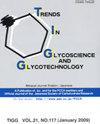Structural Analysis of GPI-glycans from GPI-anchored Proteins by Mass Spectrometry
IF 0.2
4区 生物学
Q4 BIOCHEMISTRY & MOLECULAR BIOLOGY
引用次数: 0
Abstract
Glycosylphosphatidylinositol-anchored proteins (GPI-APs) are a group of proteins anchored to glycolipid on the cell membrane and are ubiquitous in eukaryotes. The basic structure of the glycosylphosphatidylinositol (GPI) moiety comprises ethanolamine phosphate, three mannose residues, glucosamine and phosphatidylinositol (PI). This basic structure and the mechanism by which proteins are anchored to membranes via the structure are conserved among organisms. After the identification of paroxysmal nocturnal hemoglobinuria (PNH), diseases derived from GPI anchor deficiencies were discovered. To comprehend these diseases fully, a comprehensive understanding of GPI anchor biosynthesis, encompassing the intricate remodeling of glycans and lipids, becomes imperative. We used mutant strains of Saccharomyces cerevisiae in which the gene encoding the enzyme that catalyzes remodeling was knocked out and a model molecule for GPI-APs to observe the remodeling process. Herein, we introduce a method for analyzing and identifying glycan structures in GPI anchors using liquid chromatography-electrospray ionization mass spectrometry (LC-ESI MS).质谱法分析gpi锚定蛋白中gpi聚糖的结构
糖基磷脂酰肌醇锚定蛋白(GPI-APs)是一类锚定在细胞膜糖脂上的蛋白,在真核生物中普遍存在。糖基磷脂酰肌醇(GPI)部分的基本结构包括磷酸乙醇胺、三个甘露糖残基、葡萄糖胺和磷脂酰肌醇(PI)。这种基本结构和蛋白质通过这种结构固定在膜上的机制在生物体中是保守的。在确定阵发性夜间血红蛋白尿(PNH)后,发现了由GPI锚缺乏引起的疾病。为了充分了解这些疾病,全面了解GPI锚定生物合成,包括聚糖和脂质的复杂重塑,变得势在必行。我们使用敲除编码催化重塑酶的基因的酿酒酵母突变菌株和GPI-APs的模型分子来观察重塑过程。本文介绍了一种利用液相色谱-电喷雾质谱(LC-ESI MS)分析和鉴定GPI锚定中聚糖结构的方法。
本文章由计算机程序翻译,如有差异,请以英文原文为准。
求助全文
约1分钟内获得全文
求助全文
来源期刊

Trends in Glycoscience and Glycotechnology
生物-生化与分子生物学
CiteScore
0.40
自引率
0.00%
发文量
50
审稿时长
>12 weeks
期刊介绍:
TIGG is an international, bilingual journal covering glycoscience and glycotechnology and issued bimonthly since 1989. Since then editors are elected from academia and companies who agree to participate in a volunteer basis for the duration of four years.
TIGG is an official journal of the Japanese Society of Carbohydrate Research.
The journal covers the following categories.
MINIREVIEWS describe recent progress in the fields of glycoscience and glycotechnology. Suggestions are always welcome in the form of a one-page synopsis (double spaced) addressed to the editor-in-chief.
GLYCOTOPICS are short commentaries on the latest papers describing outstanding findings with background.
GLYCODEBUTS introduce distinguished PhD theses or outstanding works of young scientists over the world in glycosciences and glycotechnologies.
GLYCOFORUM is for our readers who wish to submit comments on scientific or social matters related to glycoscience and glycotechnology.
LETTERS TO TIGG are for readers who wish to discuss contributions appearing in TIGG or matters related to FCCA.
 求助内容:
求助内容: 应助结果提醒方式:
应助结果提醒方式:


